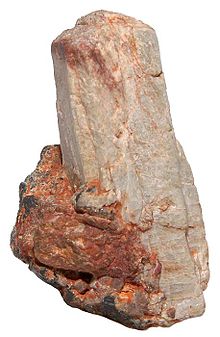
Dysprosium is a chemical element; it has symbol Dy and atomic number 66. It is a rare-earth element in the lanthanide series with a metallic silver luster. Dysprosium is never found in nature as a free element, though, like other lanthanides, it is found in various minerals, such as xenotime. Naturally occurring dysprosium is composed of seven isotopes, the most abundant of which is 164Dy.

Scandium is a chemical element; it has symbol Sc and atomic number 21. It is a silvery-white metallic d-block element. Historically, it has been classified as a rare-earth element, together with yttrium and the lanthanides. It was discovered in 1879 by spectral analysis of the minerals euxenite and gadolinite from Scandinavia.
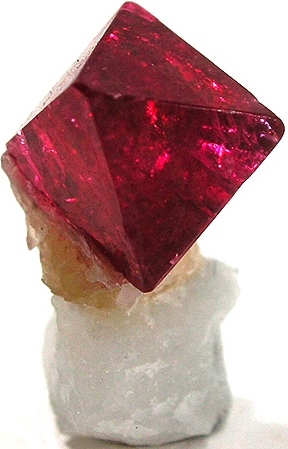
Spinel is the magnesium/aluminium member of the larger spinel group of minerals. It has the formula MgAl
2O
4 in the cubic crystal system. Its name comes from the Latin word spinella, a diminutive form of spine, in reference to its pointed crystals.

Sphalerite is a sulfide mineral with the chemical formula (Zn,Fe)S. It is the most important ore of zinc. Sphalerite is found in a variety of deposit types, but it is primarily in sedimentary exhalative, Mississippi-Valley type, and volcanogenic massive sulfide deposits. It is found in association with galena, chalcopyrite, pyrite, calcite, dolomite, quartz, rhodochrosite, and fluorite.

Group 3 is the first group of transition metals in the periodic table. This group is closely related to the rare-earth elements. It contains the four elements scandium (Sc), yttrium (Y), lutetium (Lu), and lawrencium (Lr). The group is also called the scandium group or scandium family after its lightest member.

Vegetarian nutrition is the set of health-related challenges and advantages of vegetarian diets.

Organic fertilizers are fertilizers that are naturally produced. Fertilizers are materials that can be added to soil or plants, in order to provide nutrients and sustain growth. Typical organic fertilizers include all animal waste including meat processing waste, manure, slurry, and guano; plus plant based fertilizers such as compost; and biosolids. Inorganic "organic fertilizers" include minerals and ash. The organic-mess refers to the Principles of Organic Agriculture, which determines whether a fertilizer can be used for commercial organic agriculture, not whether the fertilizer consists of organic compounds.
Mineral economics is the academic discipline that investigates and promotes understanding of economic and policy issues associated with the production and use of mineral commodities.
Luminescence dating refers to a group of chronological dating methods of determining how long ago mineral grains were last exposed to sunlight or sufficient heating. It is useful to geologists and archaeologists who want to know when such an event occurred. It uses various methods to stimulate and measure luminescence.

Ikaite is the mineral name for the hexahydrate of calcium carbonate, CaCO3·6H2O. Ikaite tends to form very steep or spiky pyramidal crystals, often radially arranged, of varied sizes from thumbnail size aggregates to gigantic salient spurs. It is only found in a metastable state and decomposes rapidly by losing most of its water content once removed from near-freezing water. This "melting mineral" is more commonly known through its pseudomorphs.

Capt. Edward Deforest Thalmann, USN (ret.) was an American hyperbaric medicine specialist who was principally responsible for developing the current United States Navy dive tables for mixed-gas diving, which are based on his eponymous Thalmann Algorithm (VVAL18). At the time of his death, Thalmann was serving as assistant medical director of the Divers Alert Network (DAN) and an assistant clinical professor in anesthesiology at Duke University's Center for Hyperbaric Medicine and Environmental Physiology.
Wassonite is an extremely rare titanium sulfide mineral with chemical formula TiS. Its discovery was announced in a 2011 NASA press release as a single small grain within an enstatite chondrite meteorite called "Yamato 691", which was found during a 1969 Japanese expedition to Antarctica. This grain represents the first observation in nature of the synthetic compound titanium(II) sulfide.
Allendeite, Sc4Zr3O12, is an oxide mineral. Allendeite was discovered in a small ultrarefractory inclusion within the Allende meteorite. This inclusion has been named ACM-1. It is one of several scandium rich minerals that have been found in meteorites. Allendeite is trigonal, with a calculated density of 4.84 g/cm3. The new mineral was found along with hexamolybdenum. These minerals, are believed to demonstrate conditions during the early stages of the Solar System, as is the case with many CV3 carbonaceous chondrites such as the Allende meteorite. It is named after the Allende meteorite that fell in 1969 near Pueblito de Allende, Chihuahua, Mexico.
Scandiobabingtonite was first discovered in the Montecatini granite quarry near Baveno, Italy in a pegmatite cavity. Though found in pegmatites, the crystals of scandiobabingtonite are sub-millimeter sized, and are tabular shaped. Scandiobabingtonite was the sixth naturally occurring mineral discovered with the rare earth element scandium, and grows around babingtonite, with which it is isostructural, hence the namesake. It is also referred to as scandian babingtonite. The ideal chemical formula for scandiobabingtonite is Ca2(Fe2+,Mn)ScSi5O14(OH).
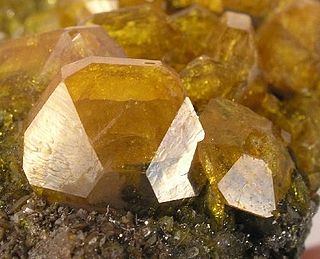
Sturmanite is a rare sulfate mineral with the chemical formula Ca6Fe3+2(SO4)2.5(B(OH)4)(OH)12 · 25 H2O. It crystallises in the tetragonal system and it has a Moh's hardness of 2.5. Sturmanite has a bright yellow to amber colour and falls in the ettringite group. It was named after Bozidar Darko Sturman (born 1937), Croatian-Canadian mineralogist and Curator Emeritus of Mineralogy, Royal Ontario Museum.
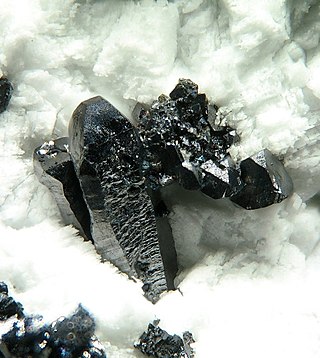
Villamanínite is a copper sulfide mineral with small amounts of other elements, belonging to group II according to the Strunz classification. It was discovered in 1920 when studying the copper minerals of the Providencia mine in the municipality of Cármenes, León (Spain). The English researchers who identified it gave it the name of villamaninite when they confused the municipality in which the mine was actually located, because Villamanín is where the ore was loaded onto the railroad for export.

Axinite-(Mg) is a borosilicate mineral of aluminum, calcium and magnesium of the axinite group, with magnesium as the dominant cation in the place of the structure that can also be occupied by iron and manganese. It was discovered in gem material from Merelani Hills, Lelatema Mts, Manyara Region, Tanzania, which is consequently its type locality. It was initially called magnesioaxinite, referring to its membership in the axinite group and the role of magnesium as the dominant cation. The International Mineralogical Association (IMA) later changed its name to axinite-(Mg). Occasionally it has been carved as a collection gem.

Kenhsuite is a mercury sulfide with chloride ions. It was described as a species from specimens obtained at the McDermitt mine, in Opalite, Humboldt Nevada county, (USA). The name is a tribute to Dr. Kenneth Junghwa Hsu. Professor Emeritus of the Swiss Federal Institute of Technology, Zurich (Switzerland).

Lizardite is a mineral from the serpentine subgroup with formula Mg3(Si2O5)(OH)4, and the most common type of mineral in the subgroup. It is also a member of the kaolinite-serpentine group.
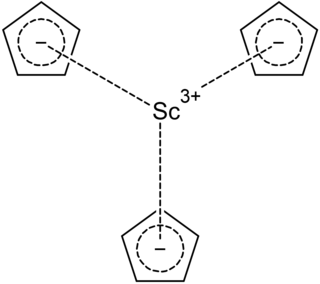
Scandocene is an organoscandium compound with the chemical formula Sc(C5H5)3. It is a straw-colored crystal and can be obtained by reacting anhydrous scandium(III) chloride and sodium cyclopentadienide in tetrahydrofuran. If scandium(III) fluoride and magnesocene are reacted as raw materials, a mixture of scandium(III) fluoride and scandocene will be obtained. It decomposes when exposed to water to produce cyclopentadiene and scandium(III) hydroxide.
